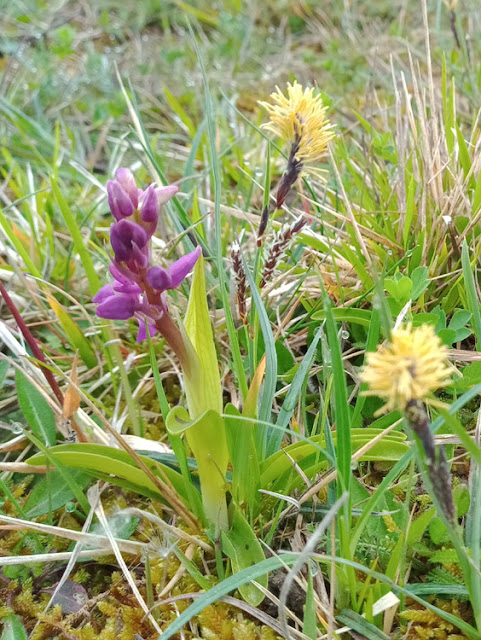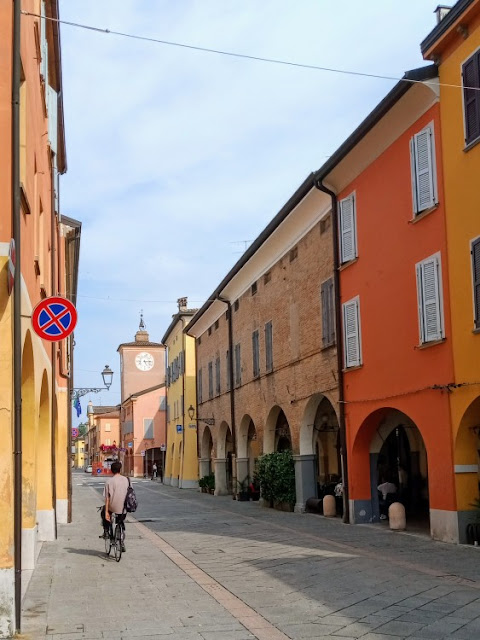Wednesday 1 May 2024
It May Be "Too Old", but it Suits Me
Tuesday 30 April 2024
Out and About in the Claise Valley in Early April
My friend Ingrid and I took ourselves on a little nature outing to check on the state of the orchids in the Claise Valley around Chaumussay on 7 April. She wanted to practice with a new macro lens, so she took most of the photos. And we saw a lot of wildlife apart from just orchids. So here is a selection.
A Red-tailed Bumble Bee Bombus lapidarius (Fr. Bourdon des pierres) queen looking for a suitable place to set up her new colony.
 |
| Photo courtesy of Ingrid de Winter. |
Lady Orchid Orchis purpurea (Fr. Orchis pourpre) bud.
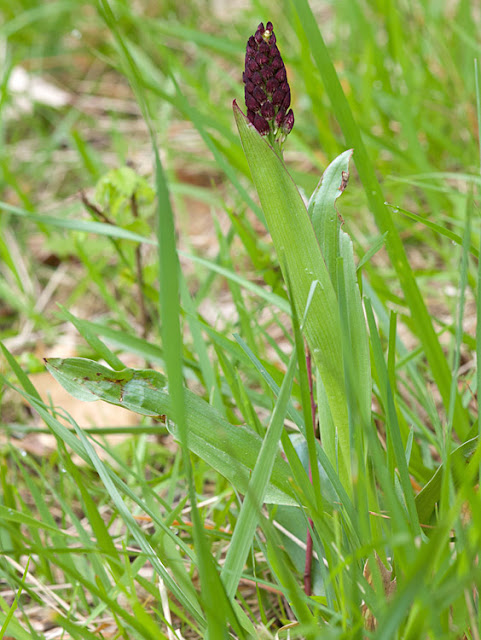 |
| Photo courtesy of Ingrid de Winter. |
Male Green Fairy Longhorn moths Adela reaumurella (Fr. Adèle verdoyante) displaying on a Wayfaring Tree Viburnum lantana (Fr. Viorne lantane), waiting for females to appear.
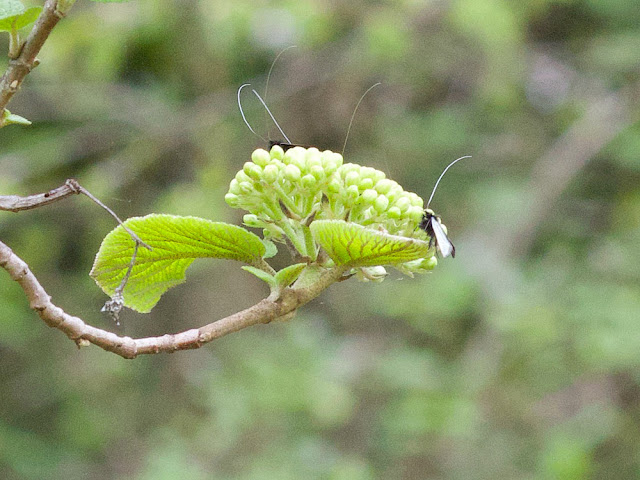 |
| Photo courtesy of Ingrid de Winter. |
Apple Blossom Beetle Tropinota hirta (Fr. Cétoine hérissée) on, you guessed it, apple blossom. The tree is a naturalised domestic apple I assume.
 |
| Photo courtesy of Ingrid de Winter. |
Lady Orchid.
 |
| Photo courtesy of Ingrid de Winter. |
The remarkarble shared tower entries to a sweat bee Lasioglossum marginatum colony. One of the little bees who occupy these tiny tunnels is centre bottom.
 |
| Photo courtesy of Ingrid de Winter. |
Green Hairstreak Callophrys rubi (Fr. Thècle de la ronce) on apple blossom. This lovely butterfly has a very short flight season, but the numbers appear to be increasing. These days I see it every year, which was not the case in the past.
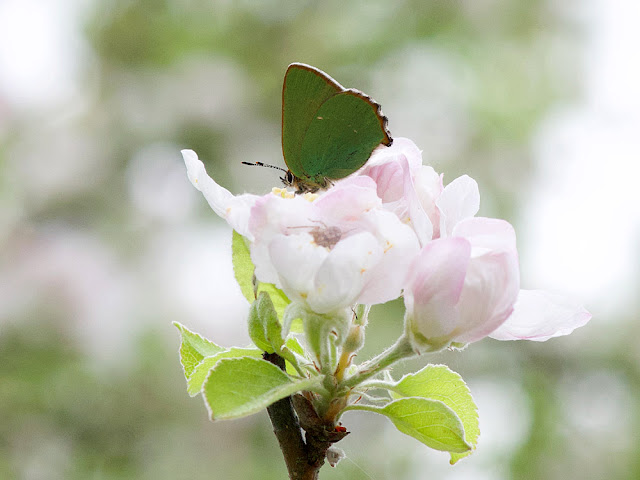 |
| Photo courtesy of Ingrid de Winter. |
The rare parasitic fly Gonia vacua. This one is male and covered in pollen.
 |
| Photo courtesy of Ingrid de Winter. |
The Second World War Demarcation line memorial at Chaumussay, on the D42 between Preuilly sur Claise and le Grand Pressigny. Conveniently, one can park there, and there is a colony of Early Purple Orchids.
 |
| Photo courtesy of Ingrid de Winter. |
Early Purple Orchid Orchis mascula (Fr. Orchis male) and Blue Sedge Carex flacca (Fr. Laîche glauque).
Cowslips Primula veris (Fr. Coucou) on the roadside at Humeau.
Monday 29 April 2024
Drinking Chocolate in a French Supermarket
There is a range of drinking chocolate powders available in my local SuperU supermarket. They do their own brand, and there are the two French classic brands, Poulain and Banania. Plus a few other multinational brands, but no Cadbury's in sight.
The Poulain product is called 'Grand Arome' ('big scent') and is manufactured in the Touraine Loire Valley, where the company began, in the mid-19th century. The standard product is 32% cacao, made with cocoa sourced in Africa, and the rest is sugar from beets grown and processed in Europe. There are a few variations, with less sugar and more cocoa. It costs around €12 a kilo.
Chocolat Poulain was created in 1848 by Victor-Auguste Poulain, a confectionary maker from Blois. Since 2017, the company has been owned by Carambar, a French company specialising in confectionary that also owns the brands Terry's, Kréma, pastilles Vichy and Suchard, with five factories in France. The emblem of Poulain is a foal, as the word 'poulain' means 'foal'. The first Poulain boutique was in the former family home in Blois of the magician Jean-Eugene Robert-Houdin, now open to the public as the Museum of Magic.
Along with Suchard (1826) and Menier (1836), Poulain is amongst the oldest chocolate brands in France and the first to engage in widespread image rich publicity campaigns. They also printed educational images which were offered free with their products, and introduced the idea of random half price vouchers which were distributed amongst their packaging for some lucky consumer to find by chance.
Banania was created in 1914 by journalist Pierre-Francois Lardet after a trip to South America where he encountered indigenous women making a drink from banana flour, cacao, cereal and sugar. It quickly became the market leader, largely thanks to generous donations of the product to the soldiers on the front line, and the use of a Senegalese sharpshooter as the brand emblem. After the Second World War though this overt association with colonialism became controversial and Poulain and Nesquik were the market leaders. Banania has struggled ever since to maintain its market share and in 2019 it closed its last factory in France. The product is now made in Germany.
Saturday 27 April 2024
A Town Called Rubiera
I knew nothing about Rubiera before we arrived, because I was treating it as just a stop along the way to Florence. Now I look at the photos and wish we'd had more time and a bit more focus.
Friday 26 April 2024
Fête St Georges 2024
These days there is no cattle market, although apparently some older residents of town remember it and rue its passing. All the local associations hold stands for renewing memberships, there are brocante style stalls, and various comestibles are available.
When we first arrived in town there were also rides and a lot of professional stalls, none of which have made it back after the dark years of Covid. This year the fete was a lot busier than the past three years so hopefully it will continue to grow.
Thursday 25 April 2024
ANZAC Biscuits
ANZAC biscuits are so named because of their association with the Australian and New Zealand Army Corps (ANZAC) from the First World War. They must contain rolled oats, sugar, butter and Golden Syrup. Usually they have dessicated coconut too. It is widely believed that Australian wives, mothers and women's groups sent the biscuits to troops fighting abroad in Europe and the Middle East because they were robust and didn't spoil on the long sea voyage to deliver them.
ANZAC is a protected term and manufacturers wishing to produce and sell these biscuits must apply to the Australian Department of Veterans Affairs. Commercially produced biscuits must adhere to the official recipe too (the only exceptions are substitutions to cater for dietary restrictions). Manufacturers must use the term 'biscuit' and not 'cookies'.
Versions of the ANZAC biscuit no doubt existed long before the First World War, but the first recipes using that name started appearing during the War, and in the decade immediately following. The first published recipes for a biscuit that is identical to the ANZAC biscuit we know and love today appeared in the 1920s.
Today they are a popular fundraiser for the Returned and Services League of Australia (RSL) and collectors buy them for the limited edition decorative tins they are packaged in.
Ingredients
1 cup plain flour
1 cup caster sugar
1 cup rolled oats
1 cup dessicated coconut
125g butter
1 tbsp golden syrup
2 tbsp boiling water
1 tsp bicarbonate of soda
Method
- Preheat oven to 180°C and line oven trays with baking paper or a silicone sheet.
- Combine flour, sugar, rolled oats and coconut.
- Melt butter and golden syrup.
- Add bicarb to boiling water and mix into butter mixture.
- Stir into the dry ingredients.
- Form the dough into large marble sized balls and drop onto trays, allowing generous room for spreading.
- Bake for 10 minutes until light golden brown.
- Cool on tray for 5 minutes before transferring to a rack to cool completely.
Makes 25 biscuits.
And in case you didn't know, today is ANZAC Day in Australia, a public holiday when Australian veterans are commemorated. Much like France on Armistice Day (11 November) there will be ceremonies at war memorials in towns big and small all over the country.
I baked ANZAC biscuits a couple of months ago for our Ukrainian Christmas event. I was pleased to see that they all went and people were keen to try them. No one had heard of them and I was intrigued that several people referred to them as 'macarons'.


